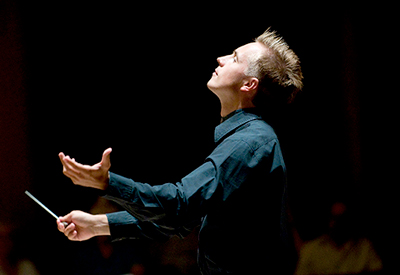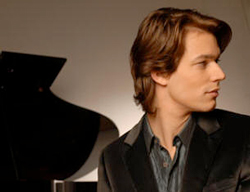by Mike Telin

On Saturday, July 29, at 8:00 pm at Blossom Music Center, Petrenko will make his Cleveland Orchestra debut in a concert that includes Mozart’s Piano Concerto No. 24 in c with David Fray as soloist, and Rachmaninoff’s Symphony No. 2 in e. “I’m really looking forward this concert, and please tell everyone that I want them to come,” the 41-year old St. Petersburg, Russia native said in his ever-present upbeat style.

We agree that Mozart’s piano concertos are all brilliant in one way or another, and Petrenko noted that No. 24 is probably one of his best known. “Mozart was a genius — he was writing concertos on his knee, scribbling very quickly without making any sketches. But to me, it seems like he spent a little more time with the c minor. It’s a unique combination of the lyrical Mozart and the playful/joyful Mozart. The combination of those two aspects of his nature is why this concerto is so popular.”
Not surprisingly, Petrenko, who has served as principal conductor of the Royal Liverpool Philharmonic Orchestra since 2006, has an affinity for the music of many Russian composers. His expansive discography includes Rachmaninoff’s first three symphonies, his four piano concertos and the Rhapsody on a Theme of Paganini with Simon Trpčeski, as well as the complete cycle of Shostakovich symphonies with the RLPO.
During recent interviews Petrenko has often spoken about how Russian and Soviet-era culture influenced the musical output of Shostakovich. He said those influences had the same effect on the music of Rachmaninoff. “The two composers were contemporaries, and yes, there are similarities, but the difference is that Rachmaninoff left the country and Shostakovich stayed and was living under those very dramatic circumstances.”
While Rachmaninoff held in his mind the Russian Empire as it existed at the end of the 19th and early 20th centuries just prior to the Revolution, Petrenko said that Shostakovich saw that Empire as it existed in the present day Soviet Union.
“He was writing about the people of Russia as he saw them every day — their strifes and their hopes. At first, Rachmaninoff thought that the Revolution was for the good and for the people, but he quickly found all the hate behind it. For example, when he went into the countryside he found that the villagers had killed his dogs, looted his house, and burned his car — he was one of the first owners of a private car in Russia. And there was no reason for it other than they felt that he was from a different class. Then when he returned to Moscow he found that the communists had thrown his piano from his third-floor apartment window.”
Although the composer and his family left Russia in December of 1917, staying briefly in Stockholm and Copenhagen before sailing to the United States in November of 1918, Rachmaninoff’s memories of the Russian Empire as it had been remained omnipresent. “On one side he was a very practical man, but he was always trying to find that lost world,” Petrenko said. “That nostalgia can be heard in his music all the way through to the Symphonic Dances.”
Following the disastrous premiere of Rachmaninoff’s First Symphony, the success of his second restored the composer’s confidence as a symphonist. “He spent a lot of time writing it, and most of it was written in Dresden. Many people think of it as being purely Russian music, but from an orchestration point of view, it is influenced by German symphonic culture and his contemporaries like Richard Strauss, who he was listening to at that moment. He was studying all of this, and of course it affected the Second Symphony. It is a stunning work and I think the second movement is one of the best-known pieces in his symphonic output.”
After some jokes about how the pop singer Eric Carmen used parts of the Symphony’s third movement in his 1976 song Never Gonna Fall in Love Again, and the coopting of classical music in “bad television commercials,” our conversation turned to the subject of new music. “Classical music should be modern, which is why in my musical life I’m paying a lot of attention to contemporary music and do quite a number of premieres every season. Classical music should be alive, otherwise we will all be in a museum — and I don’t want to be an exhibit in a museum.”
In addition to the RLPO, Petrenko holds the same position with the Oslo Philharmonic. He has recently conducted works by Emily Howard, John Corigliano, and Jennifer Higdon — whose violin concerto he has recorded with Hilary Hahn — and is set to premiere a Philip Glass symphony. He is also collaborating with many Norwegian composers.
“I think it is the duty of every orchestra and chief conductor to give a chance for local composers to have their music premiered, because then time will tell which pieces will become masterpieces and which ones will be forgotten. If you think about how much classical music has been written over the last two or three hundred years, we probably know one tenth of it at best, maybe even less. But it’s the filter of time, and a little bit of luck — for instance Mendelssohn reviving Bach, or what Leonard Bernstein did for Mahler. It’s public opinion that makes a masterpiece, but first the work needs to be premiered and not just left lying somewhere on a table.”
When not conducting, Petrenko enjoys the outdoors. “I was a cross-country skier in St. Petersburg, and Norway is an amazing country, so I wish I had more time to try downhill skiing. This summer I have done quite a lot of hiking, and swimming in the lakes. The nature here at the Tetons is amazing and reminds me so much of Norway, but a little bit warmer.”
Photo: Mark McNulty, IMG Artists.
Published on ClevelandClassical.com July 24, 2017.
Click here for a printable copy of this article



